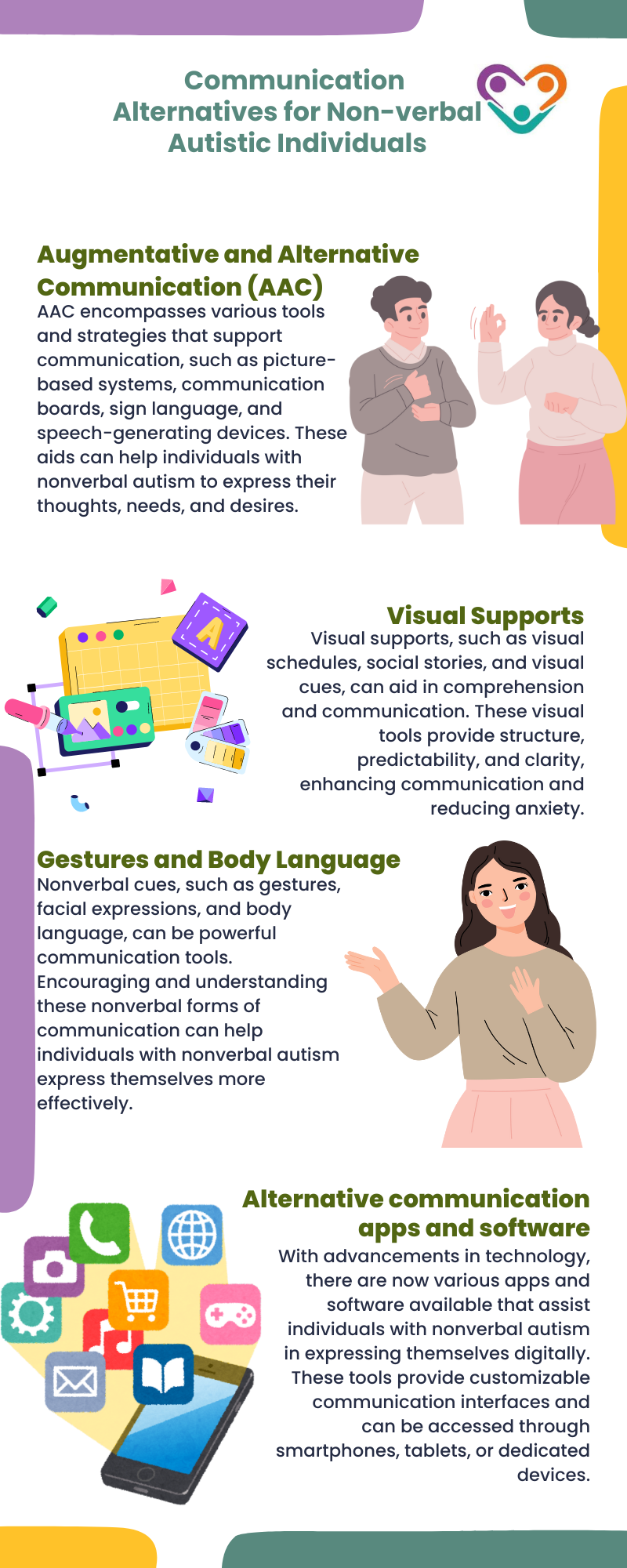Nonverbal autism refers to individuals who do not communicate using spoken language, including vocalizations or sounds with symbolic meaning.
But why exactly are there non-verbal autistic individuals? Let’s explore this topic in further detail.

Characteristics of Nonverbal Autism
Nonverbal autism is characterized by the inability to speak clearly or without interference.
Approximately 25 to 30 percent of children with Autism Spectrum Disorder (ASD) are minimally verbal, speaking fewer than 30 words, or do not speak at all, falling under the category of nonspeaking autism.
Individuals with nonverbal autism may have difficulty using words to express their needs, thoughts, or emotions. They may rely on alternative methods of communication, such as sign language, gestures, pictures, or assistive communication devices, to convey their messages.
There are several factors that can contribute to the nonverbal status of individuals with autism. These are as follows:
- Apraxia of Speech – Apraxia of speech is a motor disorder that affects the ability to coordinate the movements necessary for speech production. Some individuals with autism may experience apraxia of speech, making it challenging to articulate words and form coherent sentences.
- Underdeveloped Verbal Communication Skills – Some individuals with autism may have delayed or underdeveloped verbal communication skills. This can make it difficult for them to acquire and use spoken language effectively.
- Regression of Verbal Skills – In some cases, children with autism may lose previously acquired verbal skills as their symptoms worsen and become more noticeable. This regression can lead to a nonverbal status and a shift toward alternative forms of communication.
It’s important to note that nonverbal autism is not indicative of intelligence or cognitive ability. Many individuals with nonverbal autism have unique strengths and abilities that can be harnessed through appropriate support, therapy, and interventions.

Developmental Aspects of Nonverbal Autism
As mentioned earlier, around 25 to 30 percent of children with Autism Spectrum Disorder (ASD) are minimally verbal or do not speak at all, falling under the category of nonspeaking autism.
Some children with autism may lose verbal skills as symptoms worsen and become more noticeable, contributing to their nonverbal status.
Early signs of nonverbal autism can manifest in various ways. Delayed speech development is a common indicator, where a child with nonverbal autism may not be talking or showing signs of speech by the age of 18 months, unlike typically developing children.
Other signs may include limited or absent babbling, reduced eye contact, difficulty imitating sounds or gestures, and a lack of response to their name. It’s crucial to monitor these early signs and consult with healthcare professionals for a comprehensive evaluation and diagnosis.
Language Development Challenges
Children with ASD often have difficulty learning to talk due to primary, brain-based deficits in understanding the social, back-and-forth nature of communication. Learning to communicate precedes learning to use language. Language development challenges in nonverbal autism can vary from individual to individual.
These challenges may include difficulties in understanding and using spoken language, limited vocabulary, struggles with grammar and syntax, and challenges with pragmatic language skills (the social use of language). It’s important to provide appropriate support and interventions to address these challenges and promote communication skills.
Communication Alternatives
For individuals with nonverbal autism, finding alternative means of communication is essential. Communication alternatives can help bridge the gap and provide individuals with a means to express themselves effectively. Some commonly used communication alternatives include:

Working closely with professionals and implementing appropriate interventions can help foster effective communication and enhance the overall quality of life for individuals on the autism spectrum.
Common Misconceptions about Nonverbal Autism
Misconceptions about nonverbal autism can perpetuate misunderstandings and hinder support for individuals on the autism spectrum.
Let’s look at some of these misconceptions and attempt to address them.
IQ Misconceptions
Until relatively recently, it was commonly assumed that all nonverbal autistic individuals were intellectually disabled simply because their IQ scores fell below 70, which is the threshold for intellectual disability.
However, it is important to note that IQ scores alone do not accurately reflect an individual’s cognitive abilities or potential. Research has shown that intelligence is diverse and multifaceted, and individuals with nonverbal autism may possess strengths and abilities that are not measured by traditional IQ tests.
It is crucial to recognize and appreciate the unique talents and capabilities of individuals with nonverbal autism, rather than making assumptions based solely on IQ scores.
Neurological Differences
Research utilizing advanced techniques such as electroencephalograms (EEGs) and magnetic resonance imaging (MRI) has revealed differences in brain function among nonverbal autistic individuals.
These studies aim to better understand the underlying neurological mechanisms and brain activity in individuals who do not or cannot use spoken language.
These findings indicate that nonverbal autism is not solely a result of intellectual disability, but rather a complex interplay of neurological factors that affect communication.

Personal Choice in Communication
The reasons why some autistic individuals are nonverbal or do not use spoken language are still not fully understood. While some nonverbal individuals on the autism spectrum may face challenges in verbal communication, many choose alternative means of communication.
American Sign Language (ASL), picture cards, and digital tools are just a few examples of alternative communication methods that nonverbal individuals may adopt. It is crucial to respect and support each individual’s preferred mode of communication, as it allows them to express themselves and engage with the world around them.
By addressing these misconceptions about nonverbal autism, we can promote a more accurate understanding of the diverse experiences and capabilities of individuals on the autism spectrum.
It is essential to approach nonverbal individuals with empathy, respect, and a commitment to supporting their unique communication needs and strengths.
Research continues to shed light on the neurological basis of sensory issues in autism, offering hope for more targeted and effective therapies in the future. By recognizing and addressing sensory processing difficulties, we can improve the quality of life for individuals with autism and their families. If you’re seeking specialized ABA therapy in New Jersey, Indiana, Georgia, and New York, Golden Care offers comprehensive services tailored to meet the unique needs of each individual. Contact us to learn more or book a consultation today.
Sources:
https://www.healthline.com/health/autism/nonverbal-autism
https://www.verywellhealth.com/what-is-nonverbal-autism-260032
https://www.nm.org/healthbeat/healthy-tips/nonverbal-autism-what-it-means



